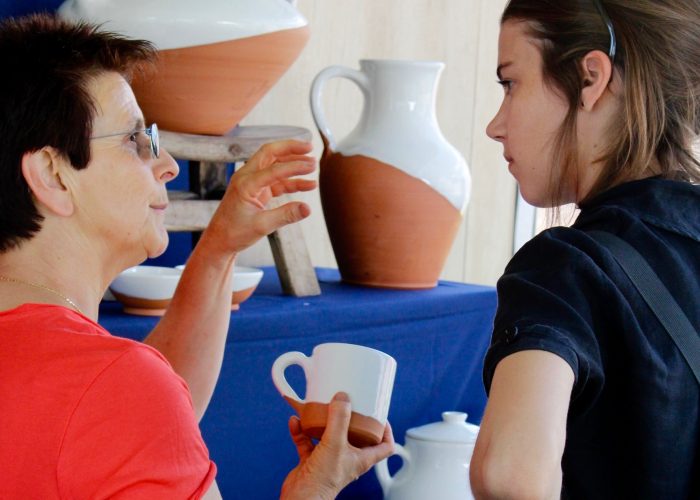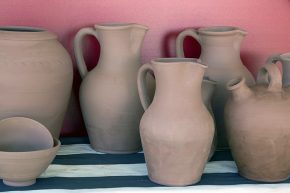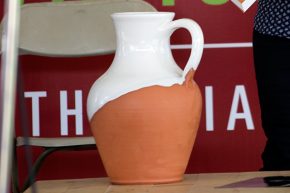Clay-Covered Memories: Master Potter Blanka Gomez de Segura

During the Folklife Festival, I found myself repeatedly drawn to the Basque pottery tent where ceramicist Blanka Gomez de Segura worked through each day on her wheel. I was hypnotized as she appeared to effortlessly guide mounds of red clay into shapely bowls, plates, pitchers, and vases.
In addition to being a master potter, Blanka is also an inviting, patient, and kind teacher. She knows that the velvet sheen and malleability of her clay invites touch, so she frequently invited visitors of all ages to her wheel.
When she invited me to try, I could barely contain my excitement. I hadn’t touched clay since the age of seven when I made a tiny lop-eared rabbit that still sits on my mother’s desk. Though we didn’t speak the same language, she guided my inexperienced hands through the process—teaching through showing. I was amazed to see a small clay bowl appear in my hands: magic that I could not have created on my own.
Blanka began learning her craft at age thirty from a seventy-year-old master, Jose Ortiz Zarate. She spent fifteen years as his apprentice. At the Festival, Blanka recounted that when she began practicing, women were not typically potters but instead were relegated to glazing and decorating the pieces. She is now one of the first female master potters specializing in euskal zeramika (Basque pottery).
She approaches her craft with scholarly intent, recreating archaeological pieces for personal and academic research. One of the pieces she displayed was a large water bowl, recreated from a third-century design. Women carried containers like this on their heads for long distances to their households. In typical Basque fashion, men turned this into a competitive rural sport, racing while balancing these pitchers on their heads.




The white glaze is a treasured Basque craft tradition. White glaze is tin-based and was made possible during the early Industrial Revolution when Basques traded iron ore for expensive English tin. To save money, pieces are often glazed only on the top half and interiors.
“It has always been utilitarian,” Blanka explained in Spanish through a translator. “There is not much ornamentation, but it was used in the home to feed families.” As Blanka worked, she explained the purpose and design of each dish, which frequently characterized by a description of the large Basque family structure.
The theme of family continued when Blanka described her experience of the Folklife Festival.
“I have been able to encounter people who left Basque country so many years back,” she said. “I feel that I am meeting members of my extended family for the first time!”
SarahVictoria Rosemann is the Folklife Festival media intern. She has a degree in ethnomusicology, with a focus in Tibetology, and grew up in Reno, Nevada.

